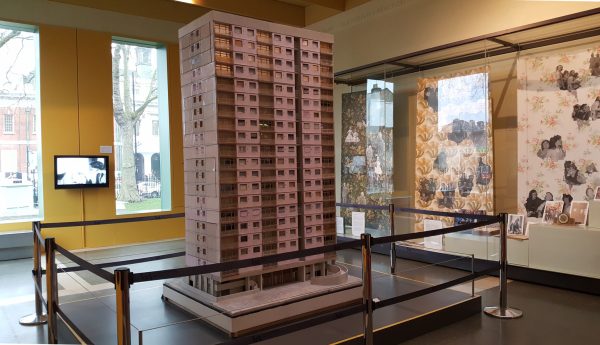A small exhibition has opened, with a gigantic model of a 1960s era tower block. The display is about the people who live, and lived in council estates, from the Victorian era Boundary Estate to the post war concrete towers.
Mostly made up of large scale photos of the homes people lived in, and some mementos of the communities.
However, it’s the huge model in the centre that dominates the display, and on my visit attracted almost all the attention.
The model itself is based on Lamas Court and Cedar Court, two of the four tower blocks that made up the Holly Street Estate in Hackney. Demolition of the run-down estate commenced in 1993, and the area is now a collection of low-rise buildings in a traditional street pattern.
Only Grange Court remains from the old estate, providing accommodation for older residents who didn’t want to mode.
The model shows the towers in all their run-down decrepitude, but also with the hints that within the block, there were real homes, cared for and lived in by people who shared the tower with people for whom this was just a place to live, not a home.
The two towers that inspired the model were demolished in 2001.
I’ve long been of the opinion that the tower block idea was not itself flawed, but the lack of investment in maintenance turned them into sinks. You only have to look at modern flats, with secure entrances and often a sizeable maintenance budget to see how the tower blocks could have been.
The display is open for the rest of this year at the Museum of Childhood.











I think you’re right. Images I’ve seen suggest these obelisks rising up out of a field of benign open space. I can see that being more attractive than the low rise buildings taking up more footprint and therefore forming intimidating labyrinths. Ironically, tower blocks can lead to lower density by one metric, area occupied by dwellings. Just a shame everthing built in the 60s was so terrible.
One futurist concept has a kilometre high tower being able to reduce swathes of sprawl to a neat package surrounded by green. There was a programme on Discovery about it some years ago.
Trouble is, the ‘benign open space’ you mention is inevitably bland expanses of litter-strewn grass. They never seem to bother with proper landscaping.
You state that “Only Grange Court remains from the old estate, providing accommodation for older residents who didn’t want to mode” I am sure that the older you get having to mode is no longer attractive.